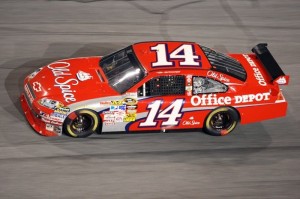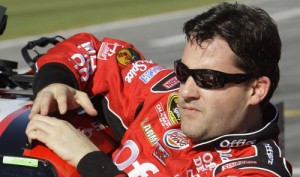“You got to know when to hold ‘em, know when to fold ‘em, know when to walk away, know when to run.” Coming from Kenny Rogers’ 1980 Grammy Award-winning song “The Gambler,” those four directives are bits of sage advice for anyone participating in a game of chance, and chance is something every NASCAR Sprint Cup Series driver is well acquainted with, especially for those competing in the 2012 Chase for the NASCAR Sprint Cup.
The stakes are always high at Talladega (Ala.) Superspeedway, site of Sunday’s Good Sam Roadside Assistance 500. The vast, 2.66-mile oval produces speeds so quick that NASCAR forces team to put carburetor-choking restrictor-plates on its engine’s intake manifold, which keeps speeds just a tick below the 200 mph mark, slowing cars enough so that if they get sideways, they won’t carry enough speed to launch into the air as the car’s aerodynamics become reversed. Chevy Impalas, Ford Fusions, Dodge Chargers and Toyota Camrys weren’t made to go 200-plus mph, even when they have crazy paint schemes and numbers painted on their roofs. Formula One machines they aren’t, and in the name of safety, the restrictor-plate is rudimentary technology that keeps these rudimentary cars grounded… most of the time.
But every now and then a launch button is pushed, and a spectacular somersault of a crash that appears over and over on the next day’s rounds of network morning shows penetrates the mainstream. Multi-car accidents, better known as Big Ones, jumble the point standings as front-runners are collected while others emerge unscathed.
The Big One is bound to happen again at Talladega, and if history is any indication, more than once during Sunday’s 188-lap contest. Who comes out with decent finishes will be the ones still in the hunt for the championship. But for those at the other end of the spectrum, their championship hopes are going to look like their racecars – unsalvageable.
Tony Stewart, driver of the No. 14 Mobil 1/Office Depot Chevrolet for Stewart-Haas Racing, enters the sixth to last race of the season fifth in points, 32 behind Chase leader Brad Keselowski. Stewart could very well emerge from Talladega atop the point standings, as he did in October 2002 en route to the first of his three Sprint Cup titles, or wind up tumbling out of championship contention because he was caught up in the Big One.
Multi-car accidents are commonplace at Talladega, and for every time that Stewart has logged a top-10, he’s also had a finish outside the top-25. His win in October 2008 and six second-place finishes are augmented by five DNFs (Did Not Finish).
What will this round of racing at Talladega bring? No one really knows. Restrictor-plate racing is like a game of high stakes poker and anything that can happen will happen at the notorious, high-banked oval. Given the track’s history, this weekend’s race at Talladega may be the biggest gamble of the 2012 Sprint Cup season.
Anyone in contention for the championship goes into this weekend’s race with no illusions. Each driver is well aware of the challenge that lies ahead, and each has a game plan for negotiating the pitfalls of restrictor-plate racing.
The old racing adage that to finish first, one must first finish is never more true than at Talladega in October. Various self-preservation tactics will be employed on Sunday to do just that, as some drivers will ride around in the back of the pack for the majority of the race in an effort to avoid the Big One, while others will race to the front of the pack and stay there so that when the Big One eventually comes, their only view of it is from their rearview mirror.
Talladega is indeed a gamble, and in order to be successful in this game of chance, it’s best not to show your hand too early. With three Sprint Cup titles and 47 career wins to his name, Stewart is as savvy as they come. The Columbus, Ind., native knows full well “you never count your money when you’re sittin’ at the table” because with the Chase taking center stage at Talladega this weekend, the championship battle can change in a heartbeat. Everyone will have a better understanding of where they stand when the dealing’s done.
TONY STEWART, Driver of the No. 14 Mobil 1/Office Depot Chevrolet for Stewart-Haas Racing:
Is the fall race at Talladega slightly more nerve-wracking, because when you’re in the Chase there’s more on the line?
“We’re looking at it as an opportunity to gain some points and positions. Every time you’re at Talladega you try to take care of yourself and your equipment by not getting yourself in compromising positions that are going to take you out of an opportunity to get you to the end of the race. For me, it’s no different whether the race is in May during the regular season or in October when I’m in the Chase.”
You’re fifth in points, 32 back of first-place Brad Keselowski. How are your Chase chances heading into Talladega?
“How do you know? I don’t think anybody can predict what’s going to happen until after you get out of Talladega. Even looking at last year, it wasn’t until Martinsville (Va.), and that was four races from the end of the year, before we really knew that we had a shot. There’s so many things that can happen this weekend. It’s just really hard to predict. It can eliminate people’s chances, and even for people who are still mathematically in it, having a good weekend at Talladega doesn’t ensure that they’re going to have a shot at the championship.”
Do you expect drivers who are in the Chase, particularly those toward the top of the standings, to lay back this weekend in an attempt to stay out of the Big One?
“I don’t know how you ever predict where you need to be to stay out of the Big One. That’s the hard thing. There’s times when if you’re up front you stay ahead of it, and there’s times when if you’re in the back you can stay away from it. But I think different drivers will have different strategies on how they want to run their race and where they want to be track position-wise to give themselves the best opportunity and make sure they’re there at the end.”
As a driver, how much input do you have in making the car go fast at Talladega?
“The race situation is a lot different from practice. You tend to have a much larger pack of cars and that makes a really big difference. But you’re still able to figure out what your car likes and dislikes in the draft during practice. It may not be exactly what you’ll experience in the race, but it’s the closest thing to it. Basically, it gives you an idea of what your car is capable of and where you need to be to make the moves you want.”
When you’re in the draft, how much control do you feel you have inside the racecar?
“It depends on the circumstances. You can’t see the air and you hit different pockets (of air). You hit a pocket where you get a real big tow or you hit a pocket where it seems they’re getting a tow and pulling you back, and you just have to play the circumstances. That’s why we spend so much time and run so many laps in practice. You just try getting in different scenarios and try to learn if you get in the middle of the draft, what does it do? Will it give you a push? Will it not give you a push? If you get next to this car, does it suck you up or does it slow you down? That’s why so many guys will stay out for so long in practice. It’s trial and error, but at the same time, it’s like pulling a pin on a grenade. You know through that process that if one guy makes a mistake, the car’s torn up for the race. It’s just a delicate balance of how hard you go, how many things you try, and how much time you spend doing it.”
How would you rate yourself as a restrictor-plate racer?
“Well, I’m not any happier about it than I’ve always been, but we’ve had a lot of success at restrictor-plate tracks, especially Talladega. We’ve run in the top-two there a gazillion times. I’m glad we’re halfway decent at it, but it’s still always frustrating when you have to rely on what everybody else does. It’s not what you do. It’s what you do along with somebody else who decides that they’re going to follow you and help you. That’s the part that frustrates you as a driver.

